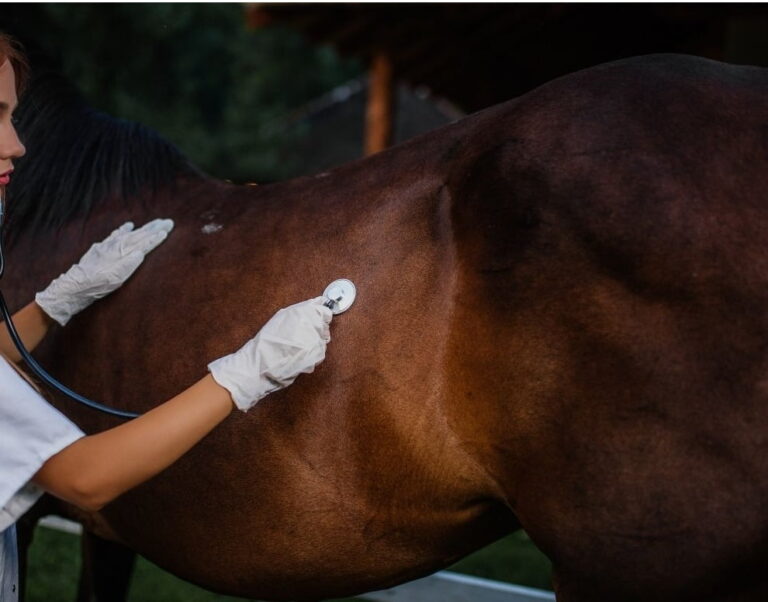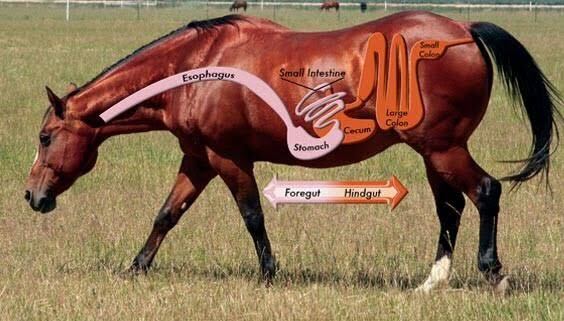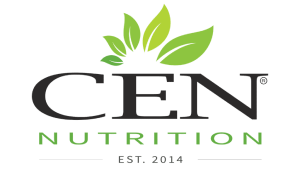
Hindgut acidosis describes a condition where the healthy microbial population within a horse’s hindgut is disrupted, causing an increase in acidity. Symptoms of a horse who may have hindgut acidosis can include an inability to gain and maintain weight, recurrent colic episodes, diarrhoea, laminitis, and recurring stereotypical behaviours such as wood chewing and weaving.
HOW DOES HINDGUT ACIDOSIS DEVELOP IN HORSES
The large intestine of the horse, which is responsible for the final stages of the digestive process, is a fermentation vat designed to provide readily available energy from volatile fatty acids, as well as other nutrients whenever they may be required by the animal. Propionic acid is a volatile fatty acid that is produced in the hindgut as a result of starch fermentation. Propionic acid may be beneficial in amounts that are not excessive for horses who require a source of quick release energy during anaerobic and aerobic exercise as it is absorbed and converted directly to glucose in the horse’s liver. Kohnke, Kelleher and Trevor-Jones (1999, p. 29) write that “high intakes of lush, rapidly growing grass pasture, or consumption of meals containing large amounts of grain, can overload increased amounts of starch and soluble highly fermentable sugars into the hindgut.” As a result, the rate of fermentation is rapidly increased, as is the production of propionic acid which may onset hindgut acidosis where the amounts produced are excessive. Kohnke, Kelleher and Trevor-Jones (1999, p. 29) also write that “the accumulation of D-lactic acid overwhelms the normal buffering efficiency and lowers hindgut pH to below an optimum of 6.5-6.8 necessary to facilitate maximum VFA production and uptake.” Where faecal pH falls below 6.4, the horse is likely to experience increased motility as a result; regularly presenting as diarrhoea or poorly formed droppings.
HINDGUT HEALTH FOR YOUR HORSE

The hindgut houses billions of microbes and protozoa that enable the digestion of cellulose and other fibrous matter. Healthy microbial populations within the hindgut can be compromised by several factors; including large volumes of undigested sugars and starches, new feed types being introduced to the diet too quickly, inadequate water consumption resulting in impaction colic, use of non-steroidal anti-inflammatory drugs, more commonly known as NSAIDs, and parasite burdens.
As the hindgut of the horse is designed to be fermenting fibrous matter, undigested sugars and starches that escape the small intestine can cause pathogenic gut microflora to multiply, while the population of healthy microbes begins to diminish as they are not adapted to fermenting these unfamiliar sugars and starches.
This promotes a build up of lactic acid within the hindgut, increasing the acidity of the environment and reducing the pH. Succeed (n.d., para. 10) writes that “a high volume of lactic acid in the bloodstream may also reduce the ability of the horse’s muscles to clear lactic acid that builds up
during exercise. This may, in turn, lead to a slower recovery from exercise or tying up.” As a result of increased production of lactic acid, the occurrence of hindgut acidosis is likely and in serious cases, disturbances throughout the hindgut can cause laminitis.
HOW TO HELP PREVENT HINDGUT ACIDOSIS
The large intestine of the horse, which is responsible for the final stages of the digestive process, is a fermentation vat designed to provide readily available energy from volatile fatty acids, as well as other nutrients whenever they may be required by the animal. Propionic acid is a volatile fatty acid that is produced in the hindgut as a result of starch fermentation. Propionic acid may be beneficial in amounts that are not excessive for horses who require a source of quick release energy during anaerobic and aerobic exercise as it is absorbed and converted directly to glucose in the horse’s liver. Kohnke, Kelleher and Trevor-Jones (1999, p. 29) write that “high intakes of lush, rapidly growing grass pasture, or consumption of meals containing large amounts of grain, can overload increased amounts of starch and soluble highly fermentable sugars into the hindgut.” As a result, the rate of fermentation is rapidly increased, as is the production of propionic acid which may onset hindgut acidosis where the amounts produced are excessive. Kohnke, Kelleher and Trevor-Jones (1999, p. 29) also write that “the accumulation of D-lactic acid overwhelms the normal buffering efficiency and lowers hindgut pH to below an optimum of 6.5-6.8 necessary to facilitate maximum VFA production and uptake.” Where faecal pH falls below 6.4, the horse is likely to experience increased motility as a result; regularly presenting as diarrhoea or poorly formed droppings.
Equine Research, https://ker.com/
horses-cecum-and-large-
https://www.succeed-equine.
https://thehorse.com/126073/
